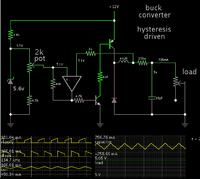cartman007
Member level 2
Hey Guys.
I want to build a little device that I will insert into my car and therefore I need a power supply that will convert the 12V from my car battery to 5V.
But this device will be on constantly.
Now the device im going to power goes on 5V at 700mA MAX!
So my questions are.
1.How long will it take a car battery to go flat if a constant 3.5Watt gets sapped?
2.What kind of power supply do I have to build if I dont want to waste 7V into heat?
I know a regulator gives of the 7V of heat by dissipating (Turning it into heat)!
I dont want to waste energy like that since its going to run constantly.So will a switchmode power supply be the one to go for?
Since it will be 12V switced on and off to such a frequency that it will only be 5V, wont that be the best way to go?
Or is my understanding of switchmodes PSUs wrong.
If I cant use a Switch mode I would like to build one.Could anyone gives me any good ICs for switchmodes that will do the trick for 12V to 5v?
Thanks
I want to build a little device that I will insert into my car and therefore I need a power supply that will convert the 12V from my car battery to 5V.
But this device will be on constantly.
Now the device im going to power goes on 5V at 700mA MAX!
So my questions are.
1.How long will it take a car battery to go flat if a constant 3.5Watt gets sapped?
2.What kind of power supply do I have to build if I dont want to waste 7V into heat?
I know a regulator gives of the 7V of heat by dissipating (Turning it into heat)!
I dont want to waste energy like that since its going to run constantly.So will a switchmode power supply be the one to go for?
Since it will be 12V switced on and off to such a frequency that it will only be 5V, wont that be the best way to go?
Or is my understanding of switchmodes PSUs wrong.
If I cant use a Switch mode I would like to build one.Could anyone gives me any good ICs for switchmodes that will do the trick for 12V to 5v?
Thanks

